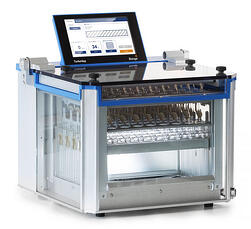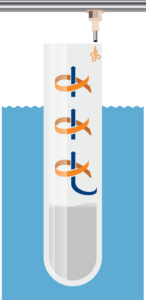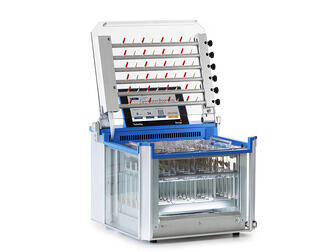If you are a chemist that is either a beginner or an expert in extracting per-and polyfluoroalkyl substances (PFAS) there are always going to be questions that come up after the extraction has taken place. Most often, questions occur at the concentration step. Such topics include water bath temperature, extract dryness, evaporation rates, and even water in the extract. How can one or all of the topics impact your analysis and where are good starting points?
One of the most asked questions I get when evaporating PFAS extracts is “how fast can I evaporate”?
This question comes up most often when faced with PFAS workflows as the extraction step can take some time. We think of PFAS as a forever analyte and that it won’t have an issue with high bath temperatures and very high nitrogen flow rates. Well believe it or not you can have lower recoveries of certain PFAS analytes with extreme temperatures and flow rates. I always approach it with this rule of thumb, don’t heat a water bath over 65 degrees Celsius. This is the same direction as in many of the EPA PFAS methods as well. As for the nitrogen stream, I think this varies based on the instrument you have available. I use the TurboVap® LV with a 48-position sample rack and set the bath temp to 60°C. Unlike other instruments the nitrogen gas and multiple ramping steps automatically increase the nitrogen vortex which plays a critical part in consistency and results. This will ensure batch to batch consistency no matter the user. Our application note Demonstration of Low PFAS Background Associated with the TurboVap® LV Automated Solvent Evaporation System has a very conservative ramping method that will provide you with success right on startup with this instrument.
as in many of the EPA PFAS methods as well. As for the nitrogen stream, I think this varies based on the instrument you have available. I use the TurboVap® LV with a 48-position sample rack and set the bath temp to 60°C. Unlike other instruments the nitrogen gas and multiple ramping steps automatically increase the nitrogen vortex which plays a critical part in consistency and results. This will ensure batch to batch consistency no matter the user. Our application note Demonstration of Low PFAS Background Associated with the TurboVap® LV Automated Solvent Evaporation System has a very conservative ramping method that will provide you with success right on startup with this instrument.
The idea is to evaporate the methanol/water mix. With any evaporating instrument this extract combination can take some time. I have conducted this evaporation myself. I was able to concentrate to dryness in 45-50 minutes with extract volumes ranging from 8-10mL with the TurboVap® LV. The water bath temperature combined with the the nitrogen vortex that is created is the key for consistency and efficiency with the extracts. I will tell you this you really want to see a vortex in the tube, not too aggressive though as this action will make the extract splatter inside the tube. The vortex action will provide two benefits. One, the nitrogen will cool and keep the more volatile analytes in the solvent instead of evaporating off. Two, the solvent in our case methanol, will be swirling and spread thin around the heated vessel and will evaporate. The greater the vortex the faster it will evaporate, so getting the right angle for the nozzle into the tube you are using really matters. But be careful if you use an aggressive evaporation method as some analytes can experience lower recoveries due to their volatility. Compounds such as PFOSA (perfluorooctane sulfonylamide), Ketose (2-N-ethylperfluorooctane sulfonamide ethanol), NMeFOSE (2-Nmethylperfluorooctane sulfonamide ethanol), and NEtFOSA (Nethylperfluorooctanesulfonamide) are all poor performers with a highly aggressive means of evaporation.
in the solvent instead of evaporating off. Two, the solvent in our case methanol, will be swirling and spread thin around the heated vessel and will evaporate. The greater the vortex the faster it will evaporate, so getting the right angle for the nozzle into the tube you are using really matters. But be careful if you use an aggressive evaporation method as some analytes can experience lower recoveries due to their volatility. Compounds such as PFOSA (perfluorooctane sulfonylamide), Ketose (2-N-ethylperfluorooctane sulfonamide ethanol), NMeFOSE (2-Nmethylperfluorooctane sulfonamide ethanol), and NEtFOSA (Nethylperfluorooctanesulfonamide) are all poor performers with a highly aggressive means of evaporation.
What I like about the TurboVap® LV is that you can manually change the angles with each row. This makes it very convenient to accommodate any type of vessel your lab might be using while maximizing your PFAS method concentration throughput without impacting results. I have done this with many types of extracts not just PFAS, and it has made an overall positive impact in end results with not only recoveries but overall concentration time.
with each row. This makes it very convenient to accommodate any type of vessel your lab might be using while maximizing your PFAS method concentration throughput without impacting results. I have done this with many types of extracts not just PFAS, and it has made an overall positive impact in end results with not only recoveries but overall concentration time.
For more information on concentrating PFAS analytes, workflows and tips please visit PFAS- Customer Solutions and Workflows.com

 Organic Workflow
Organic Workflow Peptide Workflow
Peptide Workflow Scale-Up Flash Purification
Scale-Up Flash Purification  Sample Preparation
Sample Preparation Biomolecule Purification
Biomolecule Purification Oligo synthesis
Oligo synthesis Scavengers and Reagents
Scavengers and Reagents Service & Support
Service & Support Accessories & Spare parts
Accessories & Spare parts Investors
Investors Reports & News
Reports & News The Share
The Share Corporate Governance
Corporate Governance Calendar
Calendar Sustainability
Sustainability Our Offering
Our Offering Our History
Our History Our Locations
Our Locations Leadership
Leadership
